The NZXT N7 Z370 Motherboard Review: A New Player in the Motherboard Market
by Joe Shields on January 9, 2018 12:00 PM EST- Posted in
- Motherboards
- Intel
- NZXT
- Coffee Lake
- i7-8700K
CPU Performance, Short Form
For our motherboard reviews, we use our short form testing method. These tests usually focus on if a motherboard is using MultiCore Turbo (the feature used to have maximum turbo on at all times, giving a frequency advantage), or if there are slight gains to be had from tweaking the firmware. We leave the BIOS settings at default and memory at JEDEC for the supported frequency of the processor for these tests, making it very easy to see which motherboards have MCT enabled by default.
Rendering - Blender 2.78: link
For a render that has been around for what seems like ages, Blender is still a highly popular tool. We managed to wrap up a standard workload into the February 5 nightly build of Blender and measure the time it takes to render the first frame of the scene. Being one of the bigger open source tools out there, it means both AMD and Intel work actively to help improve the codebase, for better or for worse on their own/each other's microarchitecture.
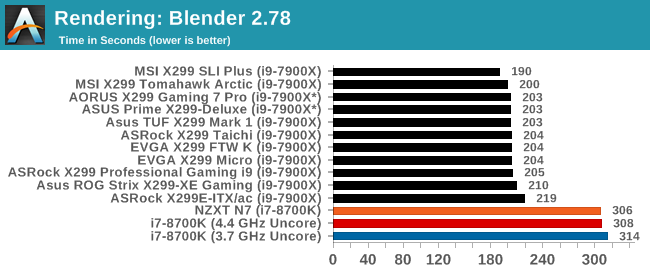
The Blender results show just how core/thread heavy Blender can use. Where most of the 7900X results are around 3 minutes and 20 seconds, the i7-8700K took over 5 minutes to complete. When mixing it up with the other i7-8700K and their varied Uncore speeds, the N7 (in Orange) and its 4.2 GHz Uncore manged to be the quickest of the bunch by two seconds.
Rendering – POV-Ray 3.7: link
The Persistence of Vision Ray Tracer, or POV-Ray, is a freeware package for as the name suggests, ray tracing. It is a pure renderer, rather than modeling software, but the latest beta version contains a handy benchmark for stressing all processing threads on a platform. We have been using this test in motherboard reviews to test memory stability at various CPU speeds to good effect – if it passes the test, the IMC in the CPU is stable for a given CPU speed. As a CPU test, it runs for approximately 1-2 minutes on high-end platforms.

POV-Ray, though sensitive to frequency, also can use a lot of cores. Again we see i9-7900X results and its 20 threads scoring a lot higher. When compared with the other 8700K results, they are all extremely close. POVRay doesn't respond to differences in Uncore it seems.
Compression – WinRAR 5.4: link
Our WinRAR test from 2013 is updated to the latest version of WinRAR at the start of 2014. We compress a set of 2867 files across 320 folders totaling 1.52 GB in size – 95% of these files are small typical website files, and the rest (90% of the size) are small 30-second 720p videos.
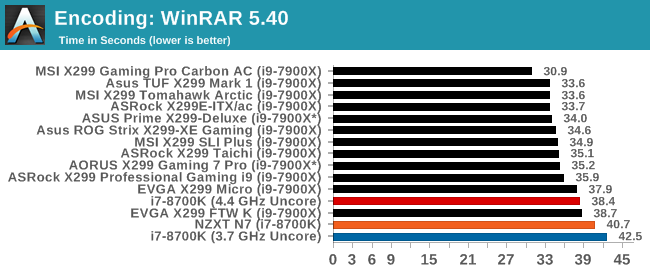
WinRAR is another test where cores and threads matter, but not quite as much as we have seen above. The NZXT N7 board drives the i7-8700K to complete this benchmark in 40.7 seconds. It ends up a mere two seconds behind the EVGA boards, which again will run this test a bit slower than the other boards. Here Uncore seems to matter more as the 4.4 GHz Uncore is a bit over two seconds faster than the N7 i7-8700K's result. It even manages to beat the i9-7900X.
Synthetic – 7-Zip 9.2: link
As an open source compression tool, 7-Zip is a popular tool for making sets of files easier to handle and transfer. The software offers up its own benchmark, to which we report the result.
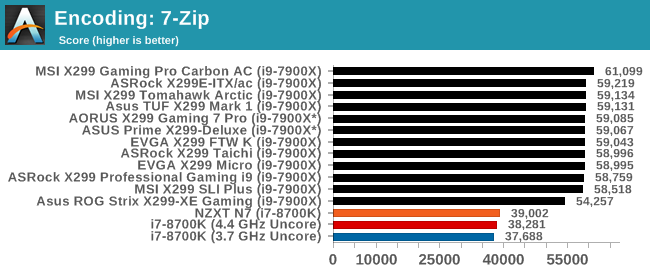
Our 7Zip results again show how much difference cores and threads can make. The N7 pushed our i7-8700K to a 39K result, notably behind the tightly packed group of results hitting almost 60K. The N7 i7-8700K's results was ahead of the other two like CPUs here by a small margin.
Point Calculations – 3D Movement Algorithm Test: link
3DPM is a self-penned benchmark, taking basic 3D movement algorithms used in Brownian Motion simulations and testing them for speed. High floating point performance, MHz, and IPC win in the single thread version, whereas the multithread version has to handle the threads and loves more cores. For a brief explanation of the platform agnostic coding behind this benchmark, see my forum post here.
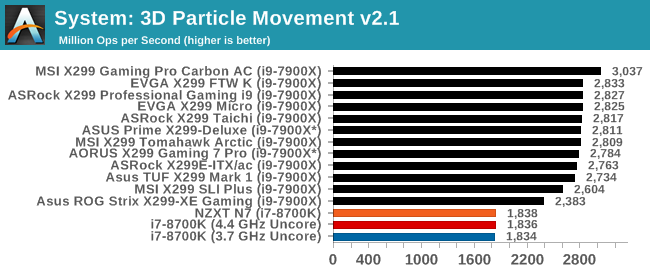
3DPM21 has the i7-8700K reaching 1838 Mop/s, with the rest of the 20 thread $1000 CPUs around 2800. Between all three i7-8700Ks the scores were nearly exactly the same.
Neuron Simulation - DigiCortex v1.20: link
The newest benchmark in our suite is DigiCortex, a simulation of biologically plausible neural network circuits, and simulates activity of neurons and synapses. DigiCortex relies heavily on a mix of DRAM speed and computational throughput, indicating that systems which apply memory profiles properly should benefit and those that play fast and loose with overclocking settings might get some extra speed up. Results are taken during the steady state period in a 32k neuron simulation and represented as a function of the ability to simulate in real time (1.000x equals real-time).
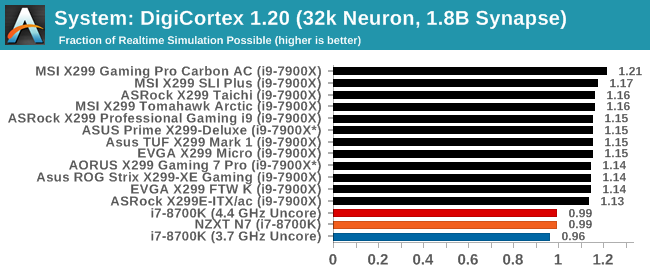
The DigiCortex results have the i7-8700K coming in at 0.99 here just barely under the threshold for simulations in real-time. The 8700K with the lowest Uncore also managed to be the slowest result. Both the N7's 4.2 GHz and the other i7 8700K's 4.4 GHz managed the same result.










60 Comments
View All Comments
tech6 - Tuesday, January 9, 2018 - link
$300 for no USB 3.1 from a brand with almost no mobo track record seems a little high.I also wish manufacturers would focus on functionality rather than gimmicks like covers, LEDs and funky colored PCBs. Not every enthusiast is 16 years old.
nathanddrews - Tuesday, January 9, 2018 - link
IO Panel 5 x USB 2.04 x USB 3.1 (5 Gbps)
1 x DisplayPort (1.2)
1 x HDMI (1.4b)
1 x Clear CMOS button2
1 x LAN (RJ45 port)
1 x Optical SPDIF Out port
1 x 7.1-ch Audio jacks
Death666Angel - Tuesday, January 9, 2018 - link
My guess is he means "USB 3.1 Gen2" as opposed to the here used "USB3.1 Gen1". The difference being one is the old USB 3.0 (5Gbit/s = Gen1) and the other is the new 10Gbit/s one. USB consortium fucked that one up pretty well.Threska - Tuesday, January 9, 2018 - link
I could see covers as part of EMI and thermal management. As well as keeping board clean, and protecting from damage.bigboxes - Saturday, January 20, 2018 - link
That's what a case is for.NZXTconvert - Tuesday, February 6, 2018 - link
No 3.1? Oh contrare. There are two on board and five at the IO panel. Perfomance-wise, it's got the 370 chipset, supports 8th gen i7, and ports at M.2 for Optane. What's your beef? As for the aesthetics, could you be any more wrongheaded? For someone my age, a great deal of the appeal this board has is that it does NOT scream of the juvenile. Every sign of clutter is countered by the covers. Seamless. I'm in a whole world of happy with this board. For this to have been any company's first venture into the market is a marvel. How many companies possibly have such bragging rights? Is it niche?? These days, what isn't? I'm putting mine in a matte black Streacom FC5 Alpha. The whole setup's going to satisfy me for a decade and more. This is a very sophisticated board. And if someone wants to spring for it with its optional candy touches, RGB and all, why not? It'll perform in either event. If there's additional functionality you wish the board had, you could state specifically what you have in mind. But insulting not only the manufacturer but its customers is so, well, trendy.HStewart - Tuesday, January 9, 2018 - link
Interesting Motherboard designed - it would be interesting to find out long term effect of such designed - cooling, serviceability and other things.megapleb - Tuesday, January 9, 2018 - link
What did I miss on the comparisons? Why it is all to i9-7900X systems instead of other Z370 motherboard?Joe Shields - Tuesday, January 9, 2018 - link
We do not have any Z370 motherboard data outside of the two others that were included with different uncore. Instead of sparse graphs we chose to add it in with the 7900X/X299 boards I have data on already.There will be more reviews on this platform with data comparing it to like systems.
Slash3 - Wednesday, January 10, 2018 - link
Basically, AT needs to get reviewin' so they have something to compare it to. :)